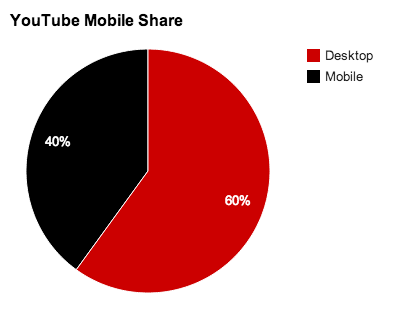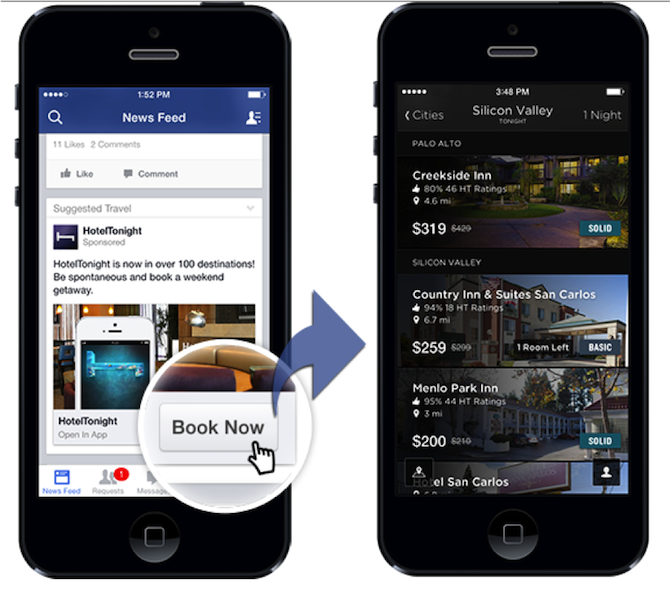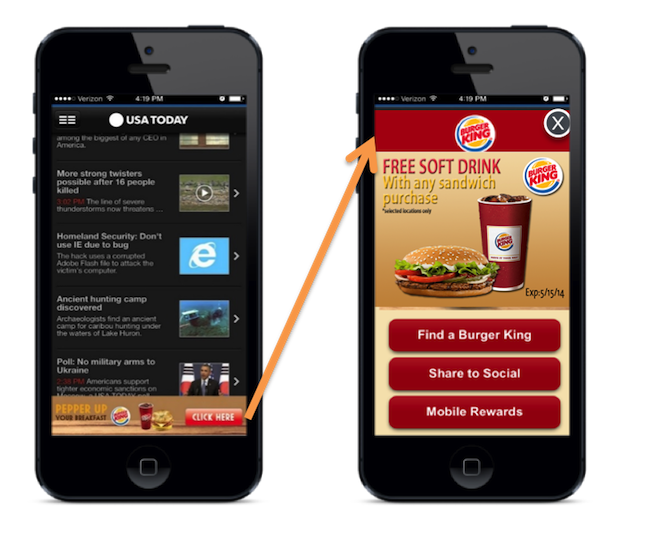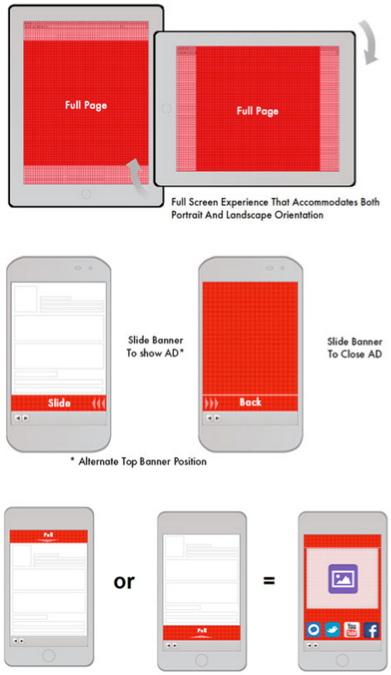Repeatedly, studies cite mobile banner ads as failing in two important ways: they’re too small, and they’re too boring. There is a lot you can do to optimize the design and targeting of a banner ad campaign—and banners are still the primary option for programmatic buying and real-time bidding—but at a certain point the inherent limitations of the format impede performance.
The static mobile banner ads that have long dominated the mobile ad unit economy are now being replaced by a variety of innovative new ad units and standards designed specifically to leverage the features and functionality unique to mobile:
-
Rich Media Mobile Ads
Mobile Native Ads
Mobile Video Ads
Mobile Engagement Ad Units
IAB Mobile Rising Stars Ads
Early results are promising, with these more engaging mobile ad units delivering several times the performance of traditional mobile banner ads.
Static Mobile Banner Ads Are Giving Way to Rich Media Ads
The term “rich media” applies to any ad that delivers a deeper consumer experience than classic (read: boring) mobile banner ads. Video, audio, animation, interactivity–any feature or features that spice up the process. All of the new ad units coming out for mobile involve rich media.
While rich media has been around for sometime in desktop ads, it is only recently that mobile browsing speeds have reached the point where the larger media files required for rich media experiences are able to load quickly on a mobile device. The dramatic increase rich media provides to ad performance is already obvious, with Opera Mediaworks reporting that rich media mobile advertising campaigns are outperforming static mobile banner ads by a nearly 400%. Millennial Media reported a similar boost to performance, with the rich media bump driving between 3-5x the CTR of static media ads, depending on the vertical. Nielsen reported more conservative–but still pomising–results: 21% of smartphone users are more likely to engage with an ad that incorporates multi-media.
It’s simple common sense–rich media is more eye-catching. More eye-catching ads get more attention, and more attention leads to more engagement and better performance at every level.
In an earlier post, we covered the best practices for rich media mobile ads.
Mobile Banner Ads vs. Mobile Video Ads
Video ads on mobile are really taking off, as consumers get more and more accustomed to watching television programs and movies on their mobile devices. YouTube reports that nearly 40% of all video watch time now happens on mobile devices. And video spots—which may be frustratingly disruptive to consumers in some digital contexts, are far less intrusive and far more effective when served as interstitial content between, say, two different levels of a gaming app.

Watching videos on mobile is now just as common as it is on any other channel
The Media & Entertainment industries are particularly big buyers of mobile video ads, with more than 50% of their mobile campaigns involving video. A 2012 Nielsen study comparing the effectiveness of video ads across devices found that mobile devices performed substantially better than both desktop computers and televisions: respectively 2.7x and 1.6x better in terms of general recall.
eMarketer projects that video ad spending will grow by 50% in 2014, going from from $4 billion to $6 billion.
-
“Don’t think of TV and Internet as separate budgets …The reason we are telling brands to think this way, is because it’s how consumers think. A consumer doesn’t care if he or she watched a video on their TV, or if it was online—they care about the content.” – Lisa Weinstein, president of global digital, data, and analytics at Starcom MediaVest Group (SMG)
Native Ads Are Stealing Social from Mobile Banner Ads
Consumers, in general, don’t like advertising. Sure, they tolerate advertising. They appreciate how it helps them make informed purchases, and maybe they even appreciate how advertising funds their favorite websites and television shows. But they still fast forward through commercial breaks. That’s where native advertising comes in. Unlike typical mobile banner ads, which deliberately jump off the page to grab consumer attention, native ads are designed to blur the distinction between content and advertising by seamlessly blending in-stream with the publisher.

Native Ads blend in seamlessly with the publisher’s site or app
AdRoll reports that Facebook ads appearing in the News Feed—appearing for all intents and purposes like ordinary Facebook posts—achieve an astonishing 49x higher click-through rate (subsequently, cost-per-click that is less than 20% that of traditional mobile banner ads on Facebook). Business Insider projects that, due to the success of native ad placements on social sites, native spend will account for 42% of all social media advertising by 2017.
Yahoo has already announced that it plans to eventually phase out all non-native display ads.
-
“In the future, all advertising on social media will be native in-stream ads. The right rail and banners will disappear altogether.” — Jan Rezab, CEO of Socialbakers
One caveat: consumers don’t like being fooled. Advertisers need to tread carefully with native ads. Though the format lends itself to much higher CTR, the end result can be negative consumer experiences if people feel “mislead” by clicking on the ad.
There is a rising tide of consumers reporting frustration with native ads; they expect click-through to deliver an actual piece of content, not blunt advertising materials. The numbers reflect this frustration: while the CTR is undeniably higher with native ads vs. mobile banner ads, the actual click-to-conversion rate—a barometer for how well-received the ad is by consumers—is substantially lower (16% lower, in the case of Facebook).
As consumers grow more savvy about native ads, performance may well decline unless advertisers make the effort to ensure these ads don’t pretend to be something they’re not.
Mobile Engagement Ad Units – Make Mobile Banner Ads Fun and Interactive
When a consumer shows enough interest in your mobile banner ads to actually click on them, you need to reward that consumer for their interest with an experience that will drive brand awareness, or even lead to measurable conversions at point of sale.

On click-through, mobile banner ads transform into a full-screen engagement experience
On click-through, Mobile Engagement Ad Units transform to deliver fun and interactive experiences in the form of customized multi-media promotions, mobile games, coupons, quizzes, surveys, and more. The ads can also provide map directions to nearby stores, and consumers can be prompted to opt-in for future offers and promotions via email, phone, or SMS.
Mobile Engagement Ad Units allow for more than just a prettier ad, or an ad unit with a single embedded video. It’s best to think of these ads as consumer “experiences,” allowing for multiple layers of mobile engagement, media, and interactive functions. A short, promotional video can link to a longer, more informative one. Interactive games can reward consumers with rich media mobile coupons that can be redeemed with the press of a button (people love pressing buttons).
IAB Mobile Rising Stars – New Standards Embrace Mobile Functionality
In 2013, the Interactive Advertising Bureau (IAB) announced 5 new mobile ad unit standards for its official portfolio, designed to leverage mobile functionality for better performance. An October 2013 study by Vibrant Media, IAB, and comScore found that users were three times more likely to interact with Rising Stars Ads than standard mobile banners—8.5% vs. 2.8%. Video completion rates experienced a 19% lift.

The IAB Mobile Rising Stars ads offer new standards designed specifically for mobile
-
1. Filmstrip – Functions as a “window” that lets users swipe to scroll through a variety of content.
2. Pull – Standard top or bottom mobile banner ads that the user drags vertically to reveal fullscreen ads.
3. Adhesion Banner – Standard mobile banner ads that “adhere” to the mobile screen—maintaining consistent position and size, regardless of how site content is manipulated (i.e. zoomed, rotated, etc).
4. Slider – Standard top or bottom mobile banner ads that the user slides horizontally to reveal fullscreen ads.
5. Fullscreen Flex – A fullscreen ad format involving responsive creative elements that automatically re-arrange to look great in both landscape and portrait orientations.
Whatever the format, the dramatically improved performance of these new mobile ad units is easy to attribute: unlike traditional mobile banner ads, these ad units are designed specifically for mobile devices, rather than simply being old-fashioned desktop ads repurposed on smaller screens.
-
“Whenever new media emerge—consider television in the 1940s and 1950s and the World Wide Web in the 1990s—there’s a period of fumbling while marketers try to repurpose ads that worked in the old media. That’s why early-1950s TV commercials featured narrators reading what were essentially radio advertisements, and why 1990s websites were filled with static display ads taken directly from print campaigns.” – Sunil Gupta
To learn more about mobile advertising, download our free eBook: 8 Secrets To Mobile Advertising Success

